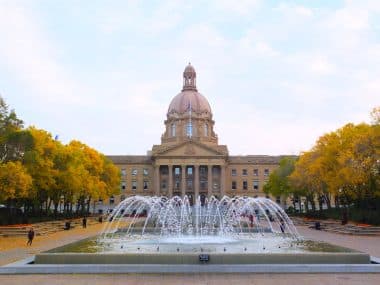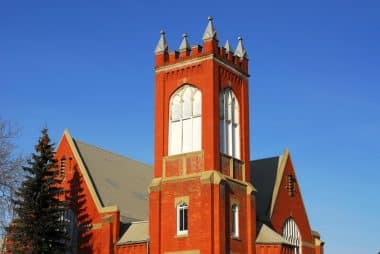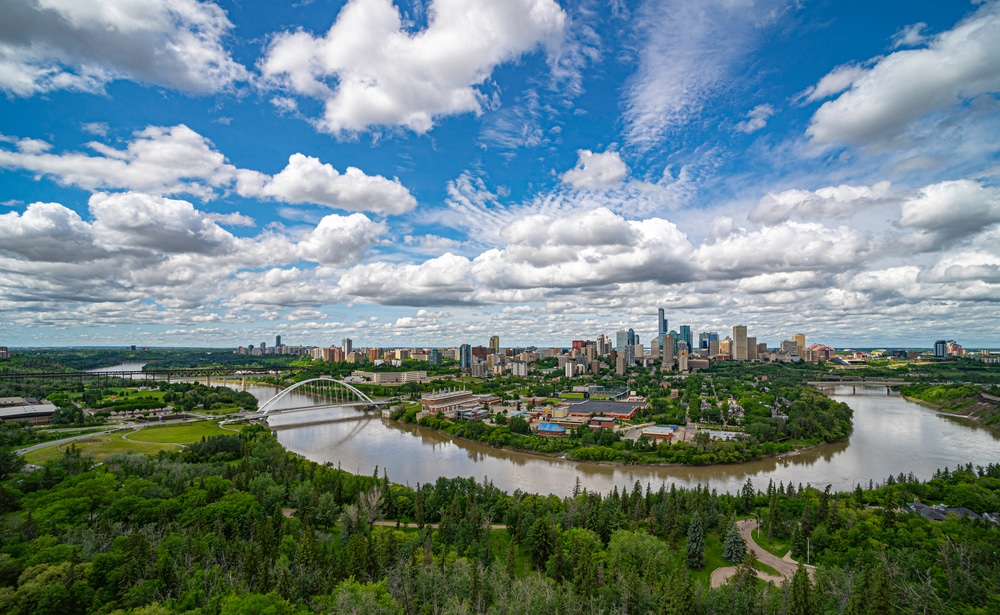The city of Edmonton in the western part of Canada, with a population of around 930,000, is the capital of the province of Alberta and the fifth largest city in Canada. The city, which emerged from a fort founded at the end of the 18th century, is an exciting destination for travelers for various reasons. Edmonton has enormous parks that are organically interwoven with the metropolitan infrastructure. In addition, the city is home to more than 60 museums and galleries with a wide variety of exhibition and collection focuses. As “The Festival City”, Edmonton also hosts numerous festivals every year, especially in summer, to which artists from all over the world travel.
History

Even before the arrival of the Europeans, members of the First Nations lived in the flat area around the North Saskatchewan River. Around 1750, the first European settlers came from the east to reach here. In 1795, the Hudson Bay Company, a British trading company, founded Fort Edmonton as a trading base on the banks of the river. The fur trade in particular flourished, so that more settlers soon settled. However, it was not until the construction of a railway line towards the end of the In the 19th century, the small settlement began to transform into a city. During the Klondike Gold Rush, Edmonton grew faster and faster and developed into the cultural and economic center of Alberta. In the second half of the In the 20th century, Edmonton changed greatly as a result of oil discoveries in the area around the city. Economic boom and crisis phases alternated with each other.
Attractions in Edmonton
As a large city with almost a million inhabitants, Edmonton impresses at first glance above all with a number of extraordinary buildings. These include the 130-metre-high Bell Tower and the 146-metre-high Epcor Tower, which was completed in 2011. Churchill Square in the heart of Edmonton Downtown is also worth a visit. Only when exploring the city does it become apparent that Edmonton also has a large number of interesting church buildings. Some of these houses of worship, built in the early days of the city’s history, are now hidden in the shadow of the high-rise buildings. A curiosity, especially from a European perspective, is the Pedway system, which is also known from other Canadian cities. A mainly underground system of sidewalks makes it possible to cross Edmonton Downtown without having to enter the streets.
The River Valley Parks System

Edmonton has enormous parks and areas in the city area. Measured by the number of inhabitants, no other major city in North America offers so much green space. Most of the parks also form a contiguous park system along the North Saskatchewan River, which divides the city in the middle. This area alone, called the River Valley Parks System, is 74 km² in size. Some of these are landscaped parks. For the most part, however, they are largely natural areas, so that lakes and gorges can be visited here in the city area. With 160 km of hiking trails, the River Valles Parks offer plenty of space for hiking trips. In addition to this interconnected system, there are numerous other parks in Edmonton, bringing the total designated area to 111 km². Several golf courses also invite you to visit in the parks. In winter, these are often converted into winter sports facilities for cross-country skiing and similar activities.
Museums and galleries
Edmonton is home to a total of 60 museums and galleries, so there is also a lot on offer for culture-loving visitors to the city. Particularly noteworthy is the Royal Alberta Museum, which deals extensively with the history of Alberta since the settlement by European immigrants. The museum attaches particular importance to dealing with the negative aspects of this history by dedicating a lot of exhibition space to the history of Canada’s indigenous peoples. The Bearclaw Gallery, which focuses on exhibiting First Nations art, is also worth a visit with this theme in mind. In changing exhibitions, both historical and contemporary works of indigenous culture are presented here. On the other hand, the Art Gallery of Alberta, which is not least architecturally unusually designed, shows works by international artists in changing exhibitions. However, the museum’s permanent exhibition focuses primarily on works by Canadian artists.
- Royal Alberta Museum: This is the largest museum in Western Canada. It features exhibits on Alberta’s history and culture, as well as rotating international exhibitions.
- Art Gallery of Alberta: This museum is home to over 6,000 works of art and offers a variety of exhibitions, workshops, and educational programs.
- Alberta Aviation Museum: A museum dedicated to Alberta’s aviation history, with many historic aircraft and exhibits.
- TELUS World of Science: Although technically a science center and not a museum, it features many interactive exhibits and IMAX movies that fascinate visitors of all ages.
- Ukrainian Cultural Heritage Village: This is an open-air museum that depicts the lives of Ukrainian immigrants who settled in East Central Alberta in 1899-1930.
- Fort Edmonton Park: Also an open-air museum that traces the history of Edmonton from the founding of the Hudson’s Bay Company to the 1920s.
- Edmonton’s Streetcar Museum: A unique attraction where visitors can explore historic streetcars and take a ride on one of the working streetcars.
- Muttart Conservatory: While this isn’t a traditional museum, it’s an interesting botanical garden with four pyramids representing different biomes.
Festivals
Edmonton is often called “The Festival City” in Canada . Especially in the summer months, hardly a week goes by without a major cultural event taking place somewhere in the city. The 13-day Works, Art & Design Festival and the Edmonton International Fringe Festival, the second largest theatre festival in the world, are of international renown. Numerous international artists are invited to both events every year to present works and performances. The Edmonton International Street Performer’s Festival, which is all about street art, also invites performance artists from all over the world.


